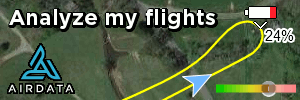Well then here is one datapoint:
17 minutes total flight, landing with 31% battery left. Distance 6 miles. Cruising speed ~30mph.
YouTube video:
Mission as flown:
Mission Hub - Litchi
Airdata UAV - Flight Data Analysis for Drones
The Airdata/healthydrone data is abridged so it gives false total mileage and max distance readings, since it stopped recording the moment RC lost signal. But total time is correct. If you export it to csv and use excel, examine rows:
2093
2094
Specifically examine column G (time stamp) To see when it last long contact and when it re-established.
The YouTube vid proves it made it all the way to the destination point as per the mission that it followed.
///////
Suffice it to say, had I flown slower, say cruising speed of 20 mph vs 30 mph, I wouldn't have made it back, much less back with 30% battery to spare.
I have flown countless missions at 20mph, earlier on, thinking it would be more fuel economical, but I was surprised to find out that flying at 30 and faster lead to much farther total distance.
///
Conclusion:
/////
Started with 100% battery, landing and shutdown with 31% battery, used total of 69% battery.
100% full bat is 3830 mAh, thus 69% of that is 2681 mAh
Total distance covered at 6 miles round trip is 31,686 ft
Thus, mAh/ft is 0.085 mAh
Total flight time in air is 17 minutes (16 minutes 58 seconds)
At average speed of 21.18 mph
That is of course accounting for the takeoff, landing, and recording in 4k 30fps, flying into the wind to take videos and get a better view of the mall once at destination, and the time spent just hovering in the air getting a GPS lock and waiting for Litchi to load and start the mission etc
But the ENTIRE trip as a whole averaged 21 mph with 0.085 mAh, which is significantly more efficent than the OP's 0.100 mAh.
///////
Let me re-measure with only the cruising segment. I elected to use a subset, from the point it lost signal to the point it reacquired signal.
Mission Hub - Litchi
Blackout duration was 9.536 minutes in length.
The total flight distance of this blackout was 4.1 miles
Thus average speed of this segment was 25.8 mph, measurably faster than the total entire overall trip speed of average of 21mph.
The question is should we expect mAH/feet to stay the same or decrease? (hence meaning faster speed is more efficient in terms of total length traveled)
Blackout period used up 47% of total battery, meaning 1800 mAH
That gets 0.083 mAh/feet
So again, average speed goes up, but average mAh/feet goes down.
At least between speed of 20 to 30, it is fair to say that faster is more fuel efficient.














